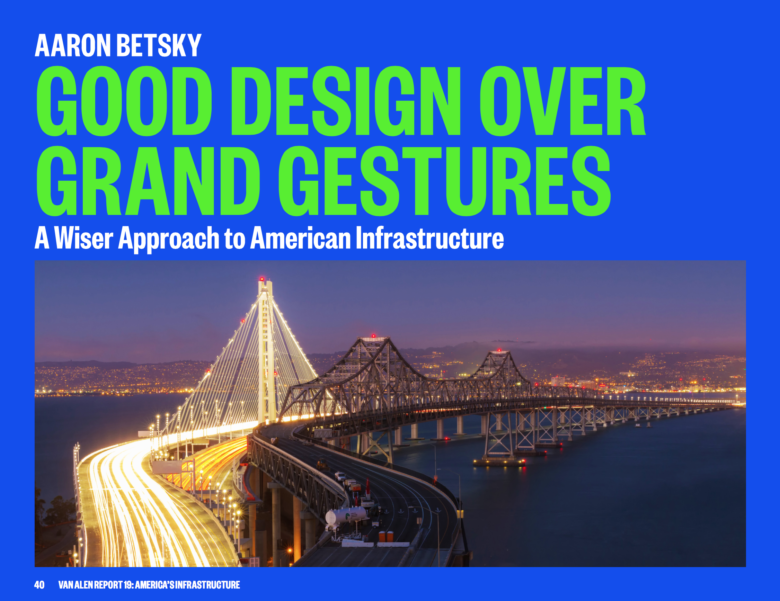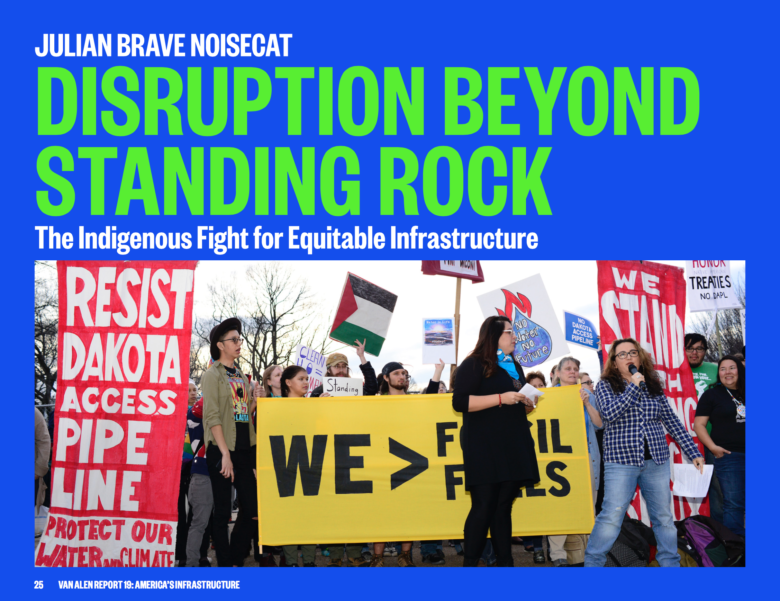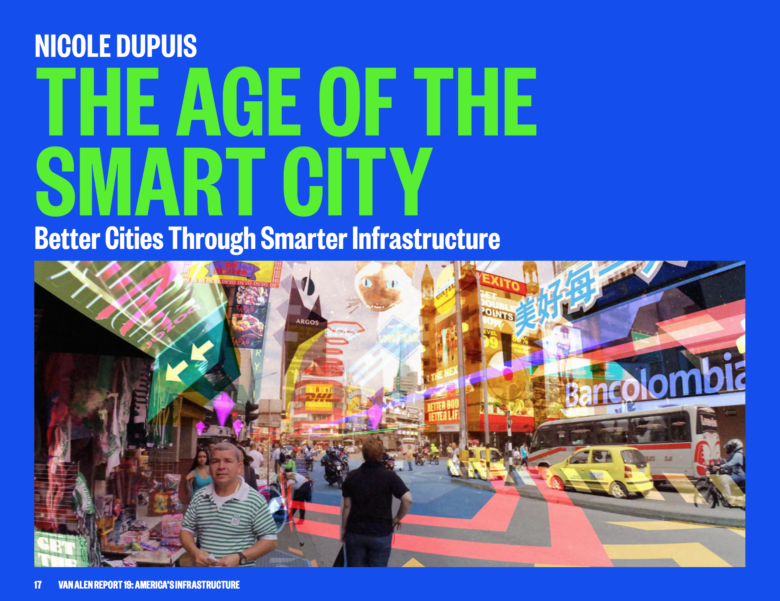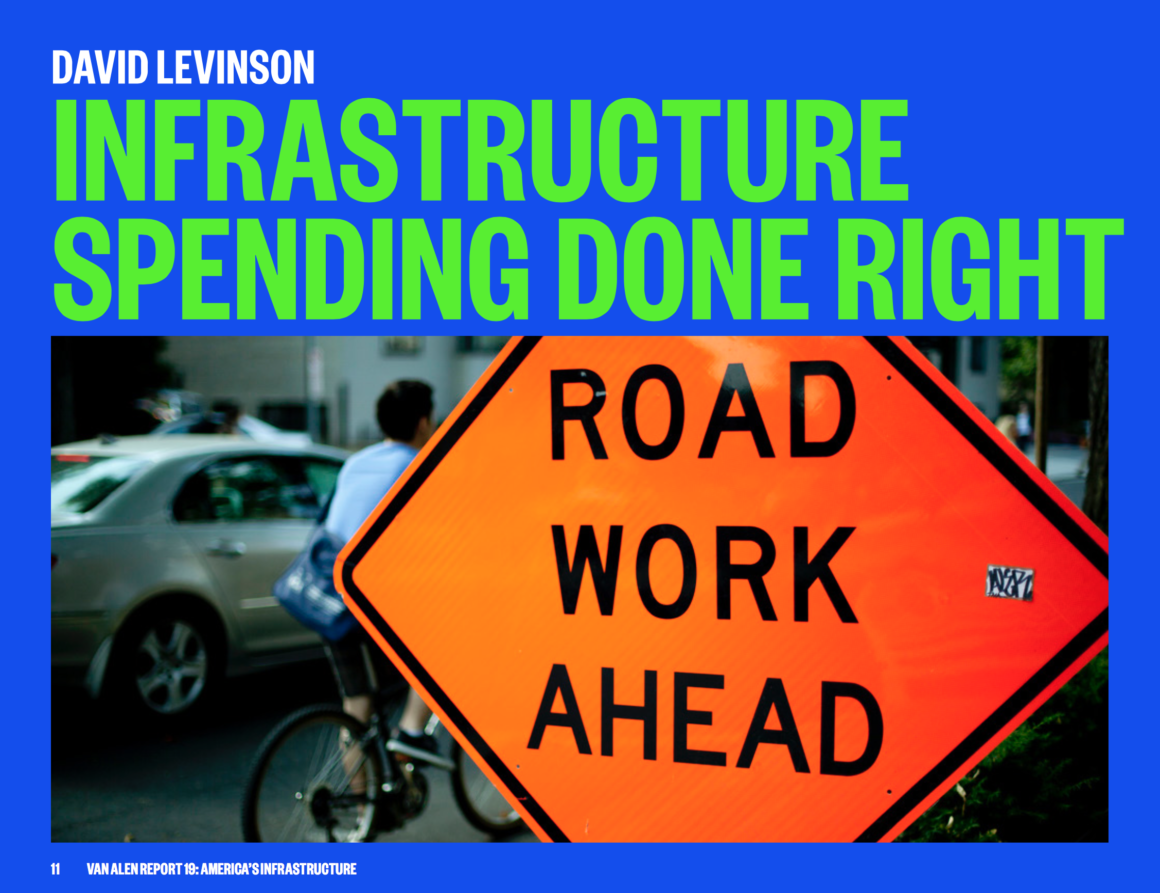
EDITOR’S NOTE
Infrastructure as stimulus spending appeals to politicians and voters because it appears to kill three birds with one stone. Critical infrastructure is repaired or newly constructed, job opportunities are created for the unemployed, and the greater economy is set on a course for growth. But how and where funding is spent can muddle these objectives. Disproportionate federal spending in rural areas over dense, growing cities undermines long- term economic impact, while growth in automation renders hope of mass job creation dubious. Moreover, politicians often prioritize new infrastructure over maintaining our vital network of existing roads, bridges, and railways. David Levinson, transportation expert and professor of civil engineering at the University of Sydney, explores the real impact of infrastructure spending and argues for the priorities that provide greater prosperity over the long term. AB
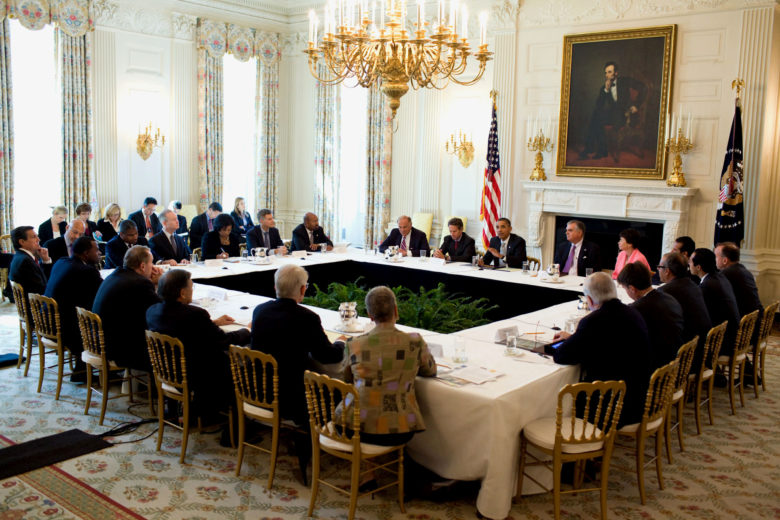
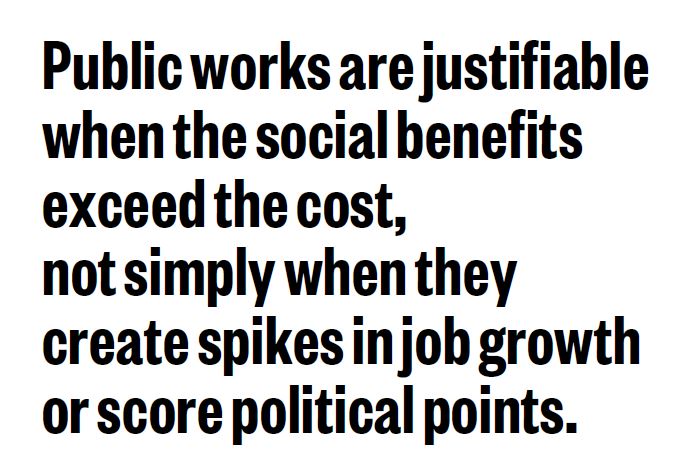
On December 6, 2008, in the throes of the Great Recession, then President- elect Barack Obama laid out key parts of his Economic Recovery Plan. In his radio address, he boldly asserted “…[W] e will create millions of jobs by making the single largest new investment in our national infrastructure since the creation of the federal highway system in the 1950s….If a state doesn’t act quickly to invest in roads and bridges in their communities, they’ll lose the money.” This plan turned into the American Recovery and Reinvestment Act, with a total budget of $831 billion. It dedicated $105 billion to infrastructure, of which $48 billion went to transport.
The value of the projects from the 2009 stimulus remains questionable. Projects tended to fall in rural areas (mostly road resurfacings) not because the work was essential, but because they were “shovel-ready” and easy to do. The projects were easy because they were already designed and had environmental permits in place. The fact that these projects were so far along in development, yet remained unbuilt, suggests that they were not the highest priorities for the local and state transportation agencies that oversaw their construction.
Though administrations have changed, the disproportionate allocation of federal spending to rural areas over more developed cities—where the majority of needed infrastructure work exists—will likely go unabated. President Trump has proposed various tax incentives to stimulate $1 trillion worth of private investment toward the nation’s infrastructure. While Trump has discussed urban-based projects, like rebuilding New York City’s poorly-managed airports, the Republican party—which he leads but which is comprised mostly of rural voters—will likely exacerbate the overfunding of rural projects even more, if only to get its own representatives and senators re-elected.
Along with project location, setting job creation as an objective of infra- structure spending can also undermine the economic value of projects. At the time of the 2009 stimulus, unemployment was around 10 percent. With more workers looking for jobs, spending on infrastructure during a recession may arguably bring labor off the side- lines, while also taking advantage of the temporary wage drop due to a spike in joblessness. In short, the state can get more infrastructure built for less and put people to work who would have otherwise been unemployed. Today, however, unemployment is around 4.7 percent. Competition for labor is up, and, with it, construction wages. Without slack in the labor market, new projects are more likely to shift employed workers around, not add new jobs to the economy. Worth noting is President Trump’s assertion that his proposed tax breaks will pay for themselves. If these privately-funded projects fail to increase the net number of jobs, the hope for additional revenue to offset tax incentives will never become reality.
Further complicating the job scenario is the capital-intensive nature of construction today. Macro-economists and policymakers who think of highways and transit lines as engines of job creation are remembering grainy black and white images of Civilian Conservation Corps workers slinging pickaxes as they built roads through national parks. Construction projects are more capital intensive than they were in the 1930s, using heavier machinery and far less labor. As technology advances, and construction equipment becomes increasingly automated, jobs will become highly skilled and decrease in number. Most infrastructure construction jobs currently require two or three years of apprenticeship and on-the-job training. In the future, infrastructure stimulus may offer little for unemployed people without extensive construction experience.
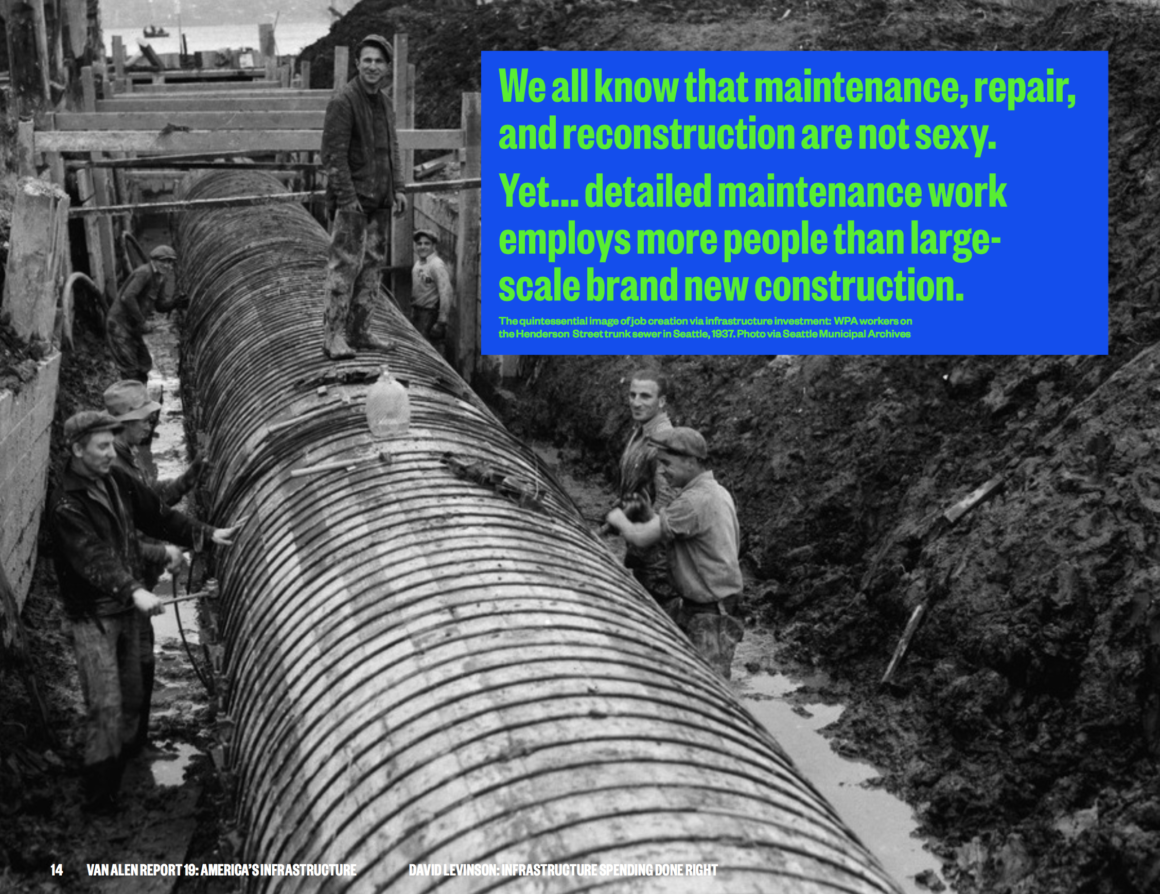
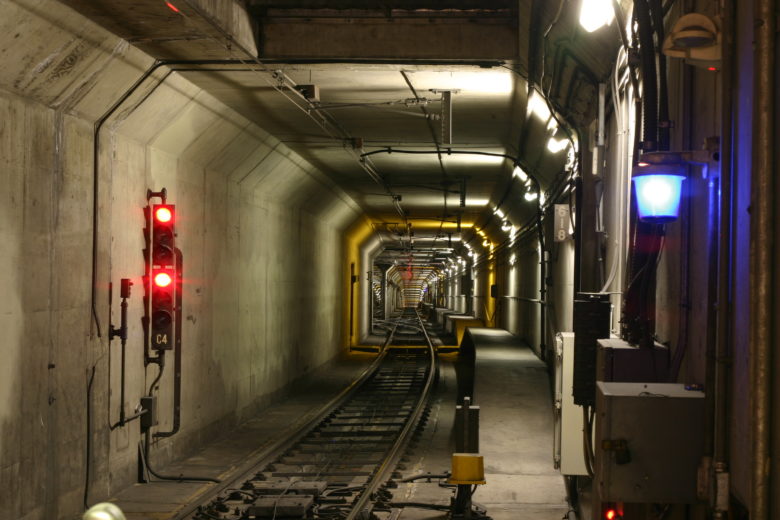
While the creation of jobs from infrastructure construction is limited, there are potential long-term benefits in terms of jobs. In most parts of the United States, our system connects every- thing worth connecting, and does so as cost-effectively as possible. There’s little need for new infrastructure, but there is, however, great urgency to rehabilitate the infrastructure we already have.
Local and state governments are generally responsible for preserving existing infrastructure. Additional federal support is helpful, but we should be sure that any support is pushed toward maintenance and not new infrastructure, which largely serves as a distraction. We all know that maintenance, repair, and reconstruction are not sexy. They do not result in ribbon cuttings with smiling politicians getting their pictures taken and posted in the local news. Yet, on a per-dollar basis, detailed maintenance work employs more people than large-scale brand new construction. Moreover, it is best to run the costly equipment required for road construction at a continuous level, thus maximizing its productivity. Continuous use is achieved by a steady rate of spending on projects, not stimulus-related spikes or failures to authorize infrastructure expenditures.
Economic activity increases with accessibility—more specifically, the ability for workers to reach jobs and stores, and for business entities to easily interact. This occurs with faster and more direct transportation, denser land use, and increased access to developed urban areas rather than less economically active rural areas. That said, it is cheaper to build in rural areas than cities, so the cost-to-benefit ratio is not obvious. This ambiguity is worth noting. While infrastructure policies may aim to even out spatial inequities and “spread the wealth,” that ambition is at direct odds with the desire to maximize the productivity and efficiency of infrastructure.
Public works are justifiable when the social benefits exceed the cost, not simply when they create spikes in job growth or score political points. To maximize the amount of infrastructure that society enjoys per dollar, the government needs to be efficient with how infrastructure money is spent. From an infrastructure perspective, if a road project employs some people, that provides a nice rhetorical flourish, but, if projects are solely aimed at employing people, the expenditure is a waste that, in the long run, shrinks the economy. The debt borrowed to build said projects ultimately comes due.
References
Anderson, Mitch (2008-10-29) Oberstar looks to job-creating infrastructure project. Star Tribune.
Congressional Budget Office (2010) Estimated Impact of the American Recovery and Reinvestment Act on Employment and Economic Output From April 2010 Through June 2010 (Table 2 CBO)
Flores de Fretos, R., Garcia-Diez, M. and Prez-Amaral, T., Public Capital Stock and Economic Growth: An Analysis of the Spanish Economy, Applied Economics, Vol. 30, No. 8,1998, pp. 985-994.
Jiwattanakulpaisarn, P., Noland, R., Graham, D. and Polak, J., Highway Infrastructure Investment and County Employment Growth: A Dynamic Panel Regression Analysis, Journal of Regional Science, Vol. 49, No. 2, 2009, pp. 263-286.
Kamps, C., The Dynamic Effects of Public Capital: VAR Evidence for 22 OECD Countries, International Tax and Public Finance, Vol. 12, Issue. 4, 2005, pp. 533-558.
Leduc and Wilson (2012) Roads to Prosperity or Bridges to Nowhere? Theory and Evidence on the Impact of Public Infrastructure Investment. Federal Reserve Bank of San Francisco Working Paper 2012-04.
Pereira, A. and Andraz, J., Public Investment in Transportation Infrastructures and Industry Performance in Portugal, Journal of Economic Development, Vol. 32,2007, pp. 1-20.
President’s Council of Economic Advisors (2009) Estimates of job creation from the American Recovery and Reinvestment Act of 2009. May 2009.
Sherk, James (2013-11-07) Additional Infrastructure Spending would Employ Few New Workers. Heritage Issue Brief #4081 on Transportation
US Bureau of Labor Statistics (2016) May 2015 National Industry-Specific Occupational Employment and Wage Estimates
US Bureau of Labor Statistics (2017) Employment, Hours, and Earnings from the Current Employment Statistics survey (National)
NAICS 237300 – Highway, Street, and Bridge Construction
US Department of Transportation, Federal Highway Ad- ministration,
“HERS-ST Highway Economic Requirements System- State Version” User’s Guide, 2009.
US Department of Transportation (2014) GROW AMERICA Act: Creating a Pathway to Transportation Careers.
US Federal Highway Administration (n.d.) Employment Impacts of Highway Infrastructure Investment. (Accessed December 16, 2016)
Zdechlik, Mark (2009-07-31) Stimulus-funded road projects create few jobs. Minnesota Public Radio
Zhang, Lei and Schonfeld, P. (2016) Estimating the economic impacts of multimodal transportation improvements. For Maryland State Highway Administration. SP409B4M FINAL REPORT

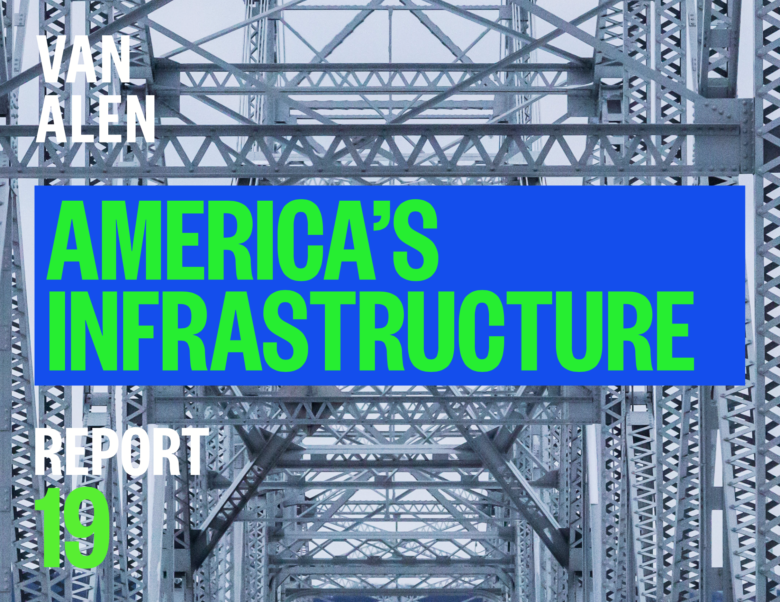
VAN ALEN REPORT 19: AMERICA’S INFRASTRUCTURE
Click below to read the full report
OTHER PERSPECTIVES in Van Alen Report 19
Nicole DuPuis, The Age of the Smart City
Julian Brave Noisecat, Disruption Beyond Standing Rock
An Interview with Steve Freiss, Lessons from Flint’s Water Crisis
Aaron Betsky, Good Design Over Grand Gestures
ENGAGE in the conversation
Please send comments and questions to vai@vanalen.org
SUBSCRIBE for future reports
